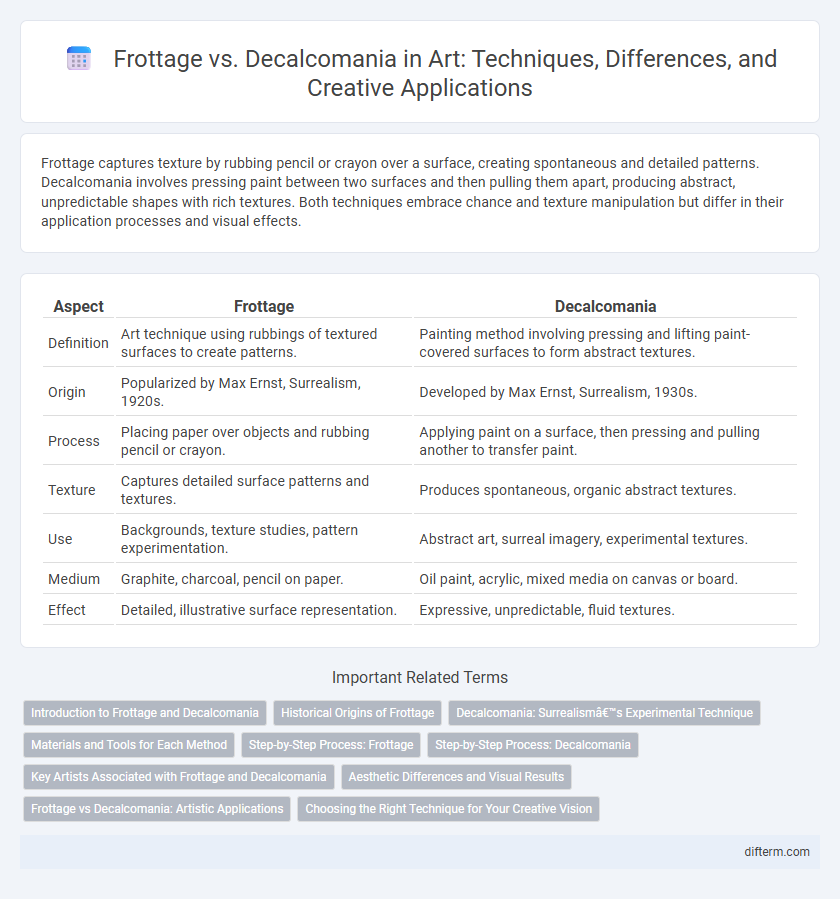Frottage captures texture by rubbing pencil or crayon over a surface, creating spontaneous and detailed patterns. Decalcomania involves pressing paint between two surfaces and then pulling them apart, producing abstract, unpredictable shapes with rich textures. Both techniques embrace chance and texture manipulation but differ in their application processes and visual effects.
Table of Comparison
| Aspect | Frottage | Decalcomania |
|---|---|---|
| Definition | Art technique using rubbings of textured surfaces to create patterns. | Painting method involving pressing and lifting paint-covered surfaces to form abstract textures. |
| Origin | Popularized by Max Ernst, Surrealism, 1920s. | Developed by Max Ernst, Surrealism, 1930s. |
| Process | Placing paper over objects and rubbing pencil or crayon. | Applying paint on a surface, then pressing and pulling another to transfer paint. |
| Texture | Captures detailed surface patterns and textures. | Produces spontaneous, organic abstract textures. |
| Use | Backgrounds, texture studies, pattern experimentation. | Abstract art, surreal imagery, experimental textures. |
| Medium | Graphite, charcoal, pencil on paper. | Oil paint, acrylic, mixed media on canvas or board. |
| Effect | Detailed, illustrative surface representation. | Expressive, unpredictable, fluid textures. |
Introduction to Frottage and Decalcomania
Frottage is a surrealist technique involving the rubbing of a pencil or other drawing tool over a textured surface to capture its patterns, while decalcomania transfers paint from one surface to another, creating abstract prints. Both methods emphasize chance and texture, allowing artists to explore subconscious imagery and spontaneity. Prominent in early 20th-century art movements, these techniques challenge traditional notions of composition and control.
Historical Origins of Frottage
Frottage, developed by surrealist artist Max Ernst in the 1920s, originated as a technique involving rubbing pencil or other drawing tools over textured surfaces to create spontaneous patterns. This method was inspired by earlier practices of frottage in archaeological and art studies used to capture surface textures of inscriptions and reliefs. In contrast, decalcomania emerged around the same period, emphasizing the manipulation of wet paint transferred between surfaces to produce abstract imagery, highlighting a distinct creative process rooted in material experimentation.
Decalcomania: Surrealism’s Experimental Technique
Decalcomania, a key Surrealist technique, involves pressing paint between surfaces to create unpredictable textures and forms, often evoking dreamlike landscapes and organic patterns. Unlike Frottage, which relies on rubbing pencil or graphite over textured objects, Decalcomania emphasizes spontaneity and chance by manipulating wet paint directly. Artists like Max Ernst popularized Decalcomania to explore the unconscious mind, making it a vital tool in Surrealism's experimental approach to automatic creation.
Materials and Tools for Each Method
Frottage involves placing paper over textured surfaces such as wood grain, leaves, or fabric and then rubbing with pencils, charcoal, or crayons to capture the texture's impression. Decalcomania requires applying thick paint layers on a canvas or glass surface, followed by pressing another surface onto the paint to create abstract, textured patterns. Tools for frottage typically include textured objects and drawing utensils, while decalcomania relies on viscous paints and smooth pressing materials like glass or metal sheets.
Step-by-Step Process: Frottage
Frottage involves placing a sheet of paper over a textured surface and rubbing it with a drawing tool like pencil, charcoal, or crayon to capture the texture's patterns, creating an impression unique to the underlying object. Artists begin by selecting varied textured objects such as wood grain, leaves, or fabric, then gently and systematically rub over the paper to emphasize different areas or details. This technique allows for spontaneous textural exploration, often serving as a foundational step in Surrealist artworks to inspire imaginative compositions.
Step-by-Step Process: Decalcomania
Decalcomania involves spreading a layer of wet paint or ink onto a surface, then pressing another surface such as paper or canvas onto it to create spontaneous, textured patterns. After pressing, the surfaces are carefully separated, revealing unique abstract forms with unpredictable details. The process can be repeated multiple times for layering effects, enhancing depth and complexity within the artwork.
Key Artists Associated with Frottage and Decalcomania
Max Ernst is a central figure in frottage, a technique involving rubbing pencil or other tools over textured surfaces to create spontaneous patterns, which he employed extensively in Surrealist art. Decalcomania, another Surrealist method characterized by pressing paint between surfaces and peeling them apart to reveal abstract textures, is famously associated with artists like Oscar Dominguez and Salvador Dali. Both techniques emphasize automatism and chance, but Ernst's frottage is more focused on revealing textures, while Dominguez and Dali's decalcomania explores dynamic, organic patterns.
Aesthetic Differences and Visual Results
Frottage produces textured, linear patterns by rubbing a pencil or other drawing tool over a surface, creating delicate, detailed impressions often resembling organic or natural forms. Decalcomania involves pressing paint between surfaces and then pulling them apart, resulting in chaotic, abstract shapes with rich, unpredictable textures and depth. The aesthetic difference lies in frottage's controlled and intricate markings contrasted with decalcomania's spontaneous, amorphous visual outcomes.
Frottage vs Decalcomania: Artistic Applications
Frottage involves creating textured impressions by rubbing pencil or other drawing tools over a surface, capturing intricate patterns and enhancing tactile qualities in artworks. In contrast, Decalcomania uses paint pressed between surfaces and then pulled apart, generating spontaneous, abstract textures that evoke organic forms. Both techniques, pioneered by Surrealists like Max Ernst, exploit chance effects to enrich visual complexity and inspire creative expression in mixed-media art.
Choosing the Right Technique for Your Creative Vision
Frottage involves creating textures by rubbing pencil or other media over paper placed on a rough surface, capturing intricate patterns ideal for detailed, organic effects. Decalcomania, by pressing and lifting paint between surfaces, produces spontaneous, abstract forms suited for surreal and expressive compositions. Selecting between frottage and decalcomania depends on whether your creative vision emphasizes controlled texture replication or unpredictable, fluid shapes in your artwork.
Frottage vs Decalcomania Infographic

 difterm.com
difterm.com